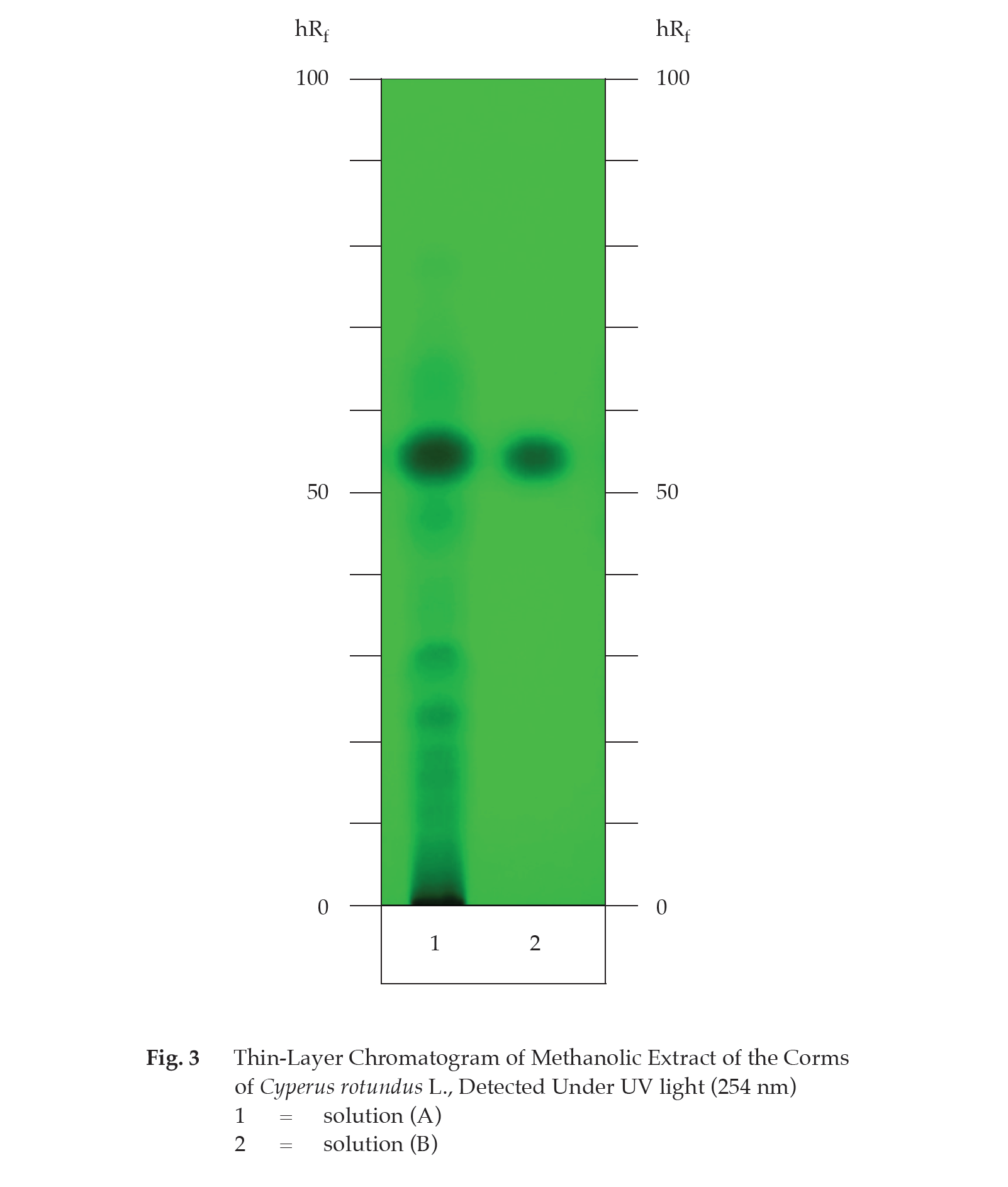ตำรามาตรฐานยาสมุนไพรไทย
Thai Herbal Pharmacopoeia
สำนักยาและวัตถุเสพติด กรมวิทยาศาสตร์การแพทย์ กระทรวงสาธารณสุข
Bureau of Drug and Narcotic, Department of Medical Sciences, Ministry of Public Health(Tinospora crispa (L.) Hook.f. & Thomson)
(Nelumbo nucifera Gaertn.)
(Centella asiatica (L.) Urb.)
(Centella Dry Extract)
(Centella Cream)
(Mesua ferrea L.)
(Piper sarmentosum Roxb.)
(Piper sarmentosum Roxb.)
(Pterocarpus santalinus L. f.)
(Santalum album L.)
(Senna tora (L.) Roxb.)
(Senna alata (L.) Roxb.)
(Senna Alata Tea)
(Piper retrofractum Vahl)
(Myristica fragrans Houtt)
(Andrographis paniculata (Burm. f.) Nees)
(Andrographis Capsules)
(Allium ascalonicum L.)
(Ocimum tenuiflorum L.)
(Curcuma longa L.)
(Turmeric Capsules)
(Turmeric Dry Extract)
(Turmeric Dry Extract Capsules)
(Arcangelisia flava (L.) Merr.)
(Curcuma sp.)
Harrisonia perforata (Blanco) Merr.
(Aristolochia pierrei Lecomte)
(Zingiber officinale Roscoe)
(Ginger Capsules)
(Ginger Tea)
(Cassia fistula L.)
(Nardostachys jatamansi (D. Don) DC.)
(Angelica sinensis (Oliv.) Diels)
Artemisia annua L.
(Ligusticum sinense Oliv. cv. Chuanxiong)
(Neopicrorhiza scrophulariiflora Pennell)
(Atractylodes lancea (Thunb.) DC.)
(Aucklandia lappa Decne)
(Terminalia chebula Retz.)
(Angelica dahurica (Hoffm.) Benth. & Hook. f. ex Franch. & Sav. var. dahurica)
(Kaempferia parviflora Wall. ex Baker)
(Hibiscus sabdariffa L.)
(Roselle Tea)
(Allium sativum L.)
(Zingiber zerumbet (L.) Sm.)
(Wurfbainia testacea (Ridl.) Škorničk.& A. D. Poulsen)
(Cannabis sativa L.)
(Myristica fragrans Houtt)
(Dracaena cochinchinensis (Lour.) S. C. Chen)
(Ficus racemosa L.)
(Hyptis suaveolens (L.) Poit.)
Clerodendrum indicum (L.) Kuntze
(Phyllanthus emblica L.)
(Citrus hystrix DC.)
(Citrus hystrix DC.)
(Areca catechu L.)
(Momordica charantia L.)
Moringa oleifera Lam.
(Aegle marmelos (L.) Corrêa)
(Solanum trilobatum L.)
(Morus alba L.)
Gynostemma pentaphyllum(Thunb.)
Makino
(Clinacanthus nutans (Burm. f.) Lindau)
(Cissus quadrangularis L.)
(Mimusops elengi L.)
(Zingiber montanum (J. König) Link. ex A. Dietr.)
(Piper betle L.)
(Capsicum annuum L.)
(Capsicum Oleoresin)
(Capsicum Gel)
(Piper nigrum L.)
(Piper nigrum L.)
(Eurycoma longifolia Jack)
(Thunbergia laurifolia Lindl.)
(Piper wallichii (Miq.) Hand.-Mazz.)
Senna garrettiana (Craib) H. S. Irwin & Barneby
(Terminalia bellirica (Gaertn.) Roxb.)
(Terminalia chebula Retz.)
(Caesalpinia bonduc (L.) H. Roxb.)
(Tarlmounia elliptica (DC.) H. Rob., S. C. Keeley, Skvaria & R. Chan)
(Hog Creeper Vine Dry Extract Capsiles)
(Hog Creeper Vine Dry Extract)
(Brachypterum scandens (Roxb.) Miq.)
(Lepidium sativum L.)
(Nigella sativa L.)
(Cuminum cyminum L.)
(Foeniculum vulgare Mill.)
(Plantago ovata Forssk.)
(Pimpinella anisum L.)
(Carum carvi L.)
(Anethum graveolens L.)
(Trachyspermum ammi (L.) Sprague)
Albizia procera (Roxb.) Benth.
(Acorus calamus L.)
(Tiliacora triandra (Colebr.) Diels)
Cyanthillium cinereum (L.) H. Rob.
(Orthosiphon aristatus (Blume) Miq.)
Murdannia loriformis (Hassk.) R. S. Rao & Kammathy
(Capparis micracantha DC.)
(Chrysopogon zizanioides (L.) Roberty)
(Cyperus rotundus L.)
(Cannabis sativa L.)
(Syzygium aromaticum (L.) Merr. & L. M. Perry)
(Boesenbergia rotunda (L.) Mansf.)
(Acanthus ebracteatus Vahl)
(Acanthus ilicifolius L.)
(Kaempferia galanga L.)
(Curcuma comosa Roxb.)
Betula alnoides Buch.-Ham. ex D. Don
Cannabis sativa L.
Carthamus tinctorius L
Mitragyna speciosa (Korth.) Havil
Mallotus repandus (Rottler) Müll. Arg
Azadirachta indica A. Juss. var. siamensis Valeton
Azadirachta indica A. Juss. var. siamensis Valeton
Punica granatum L.
Rhinacanthus nasutus (L.) Kurz
Baliospermum solanifolium (Burm.) Suresh
Curcuma aeruginosa Roxb
Boesenbergia kingii Mood & L. M. Prince
Senegalia rugata (Lam.) Britton & Rose
Acacia concinna (Willd.) DC.
Senegalia rugata (Lam.) Britton & Rose
Acacia concinna (Willd.) DC.
Senna alexandriana Mill. var. alexandriana
Cassia acutifolia Delile, Cassia angustifolia Vahl
Butea superba Roxb. ex Willd.
[Plaso superba (Roxb. ex Willd.) Kuntze, Rudolphia superba (Roxb. ex Willd.) Poir.
Pueraria candollei Graham
ex Benth. var. mirifica (Airy Shaw & Suvat.) Niyomdham
Streblus asper Lour.
Suregada multiflora (A. Juss.) Baill. (Gelonium
multiflorum A. Juss.
Cyperus Rotundus Corm is the dried corm of Cyperus rotundus L. (Family Cyperaceae), Herbarium Specimen Number: DMSC 5306, Crude Drug Number: DMSc 1201.
Constituents Cyperus Rotundus Corm contains a volatile oil, of which cyperotundone and cyperene are its major components. It also contains flavonoids, etc.
Description of the plant (Fig. 1) Perennial herb, 10 to 60 cm tall, stoloniferous; culm trigonous, glabrous, tuberous at base; corm fusiform, ovoid or ellipsoid, 0.7 to 2.3 cm long, 0.5 to 1 cm in diameter, blackish brown, woody; stolons long creeping. Leaves basal, 3-ranked, blade linear, up to 60 cm long, 2 to 6 mm wide, apex acuminate, margin entire, greyish green to dark green, scabrous, flattish, longitudinally grooved in the middle; leaf sheath pale brown, sometimes with reddish tint, becoming fibrous. Inflorescence terminal, usually compound umbel-like spike; involucral bracts 2 to 5, leaf-like, 2 to 35 cm long, 0.5 to 4 mm wide; primary branch 2 to 12 cm long, secondary branch (if present), 0.7 to 2 cm long; spike 1.5 to 5 cm long, axis 2 to 8 mm long; spikelets 3 to 10 per spike, suberect to patent, narrowly oblong to linear, 1 to 3 cm long, 1.5 to 3 mm wide, flattened, axis more or less straight, winged; glumes 2-ranked, 9 or more on the longest spikelet, ovate to ovate-elliptic, 3 to 3.5 mm long, about 2 mm wide, obtuse, mucronate, 5- to 7-nerved, reddish or purplish brown with pale narrow hyaline margin, keel greenish; stamens 3, anther about 1 mm long; ovary superior, unilocular, 1-ovuled; style 1.3 to 3.5 mm long, stigmas 3, 1.8 to 3.3 mm long, exserted from glume. Nutlet cylindric to obovoid-cylindric, trigonous, 1.3 to 1.5 mm long, 0.5 to 0.7 mm wide, brown to blackish brown, minutely punctate.
Description Odour, mildly aromatic, spicy; taste, slightly spicy and bitter.
Macroscopical (Fig. 1) Subglobose, fusiform, ovoid or ellipsoid, 0.7 to 2.3 cm long, 0.5 to 1 cm in diameter, some slightly curved; externally dark brown or black with several distinctive annular rings , with remnants of fibrous root scars, or sometimes somewhat glabrous with indistinctive roots scars; texture hard and tough.
Microscopical (Figs. 2a, 2b, 2c) Transverse section of the corm shows epidermis, cortex and vascular tissue. Epidermis: a single layer of yellow to brownish yellow polygonal cells. Cortex: groups of reddish brown fibres, storied cork, sclerenchyma, thin-walled ovate to round parenchyma, some containing starch grains and/or reddish brown oleoresins, secretory cells containing reddish brown substance and enclosed by 5 to 8 parenchyma cells; pseudoendodermis, 1 to 2 layers of thick-walled subrectangular or subround cells. Vascular tissue: scattering collateral vascular bundles in the outer pseudoendodermis region and amphivasal vascular bundles in the inner pseudoendodermis region, both of which enclosed by 1 to 3 layers of lignified fibres.
Cyperus Rotundus Corm in powder possesses the diagnostic microscopical of the unground drug. Secretory cells enclosed by parenchyma and groups of reddish brown fibres are characteristic.
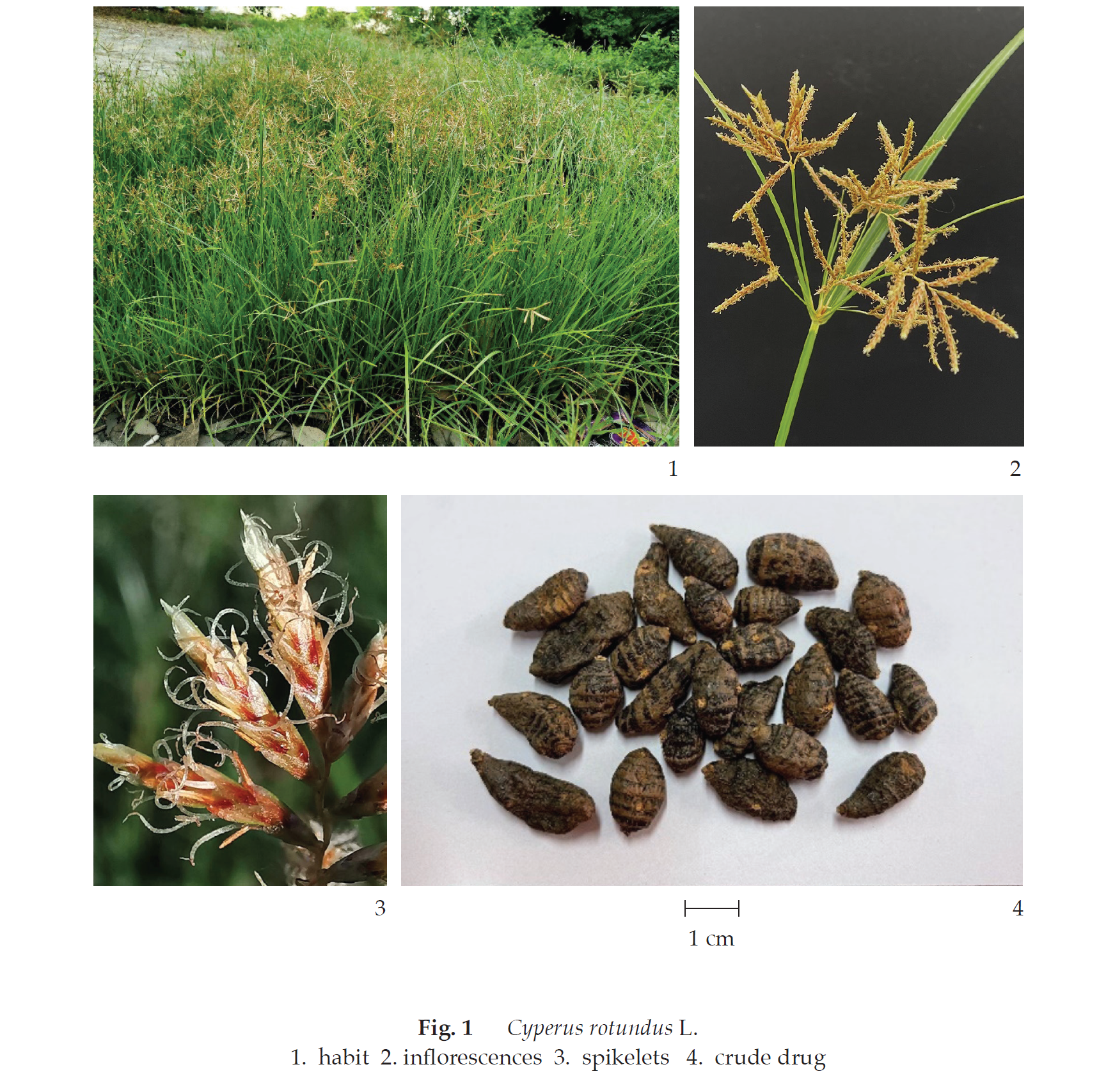
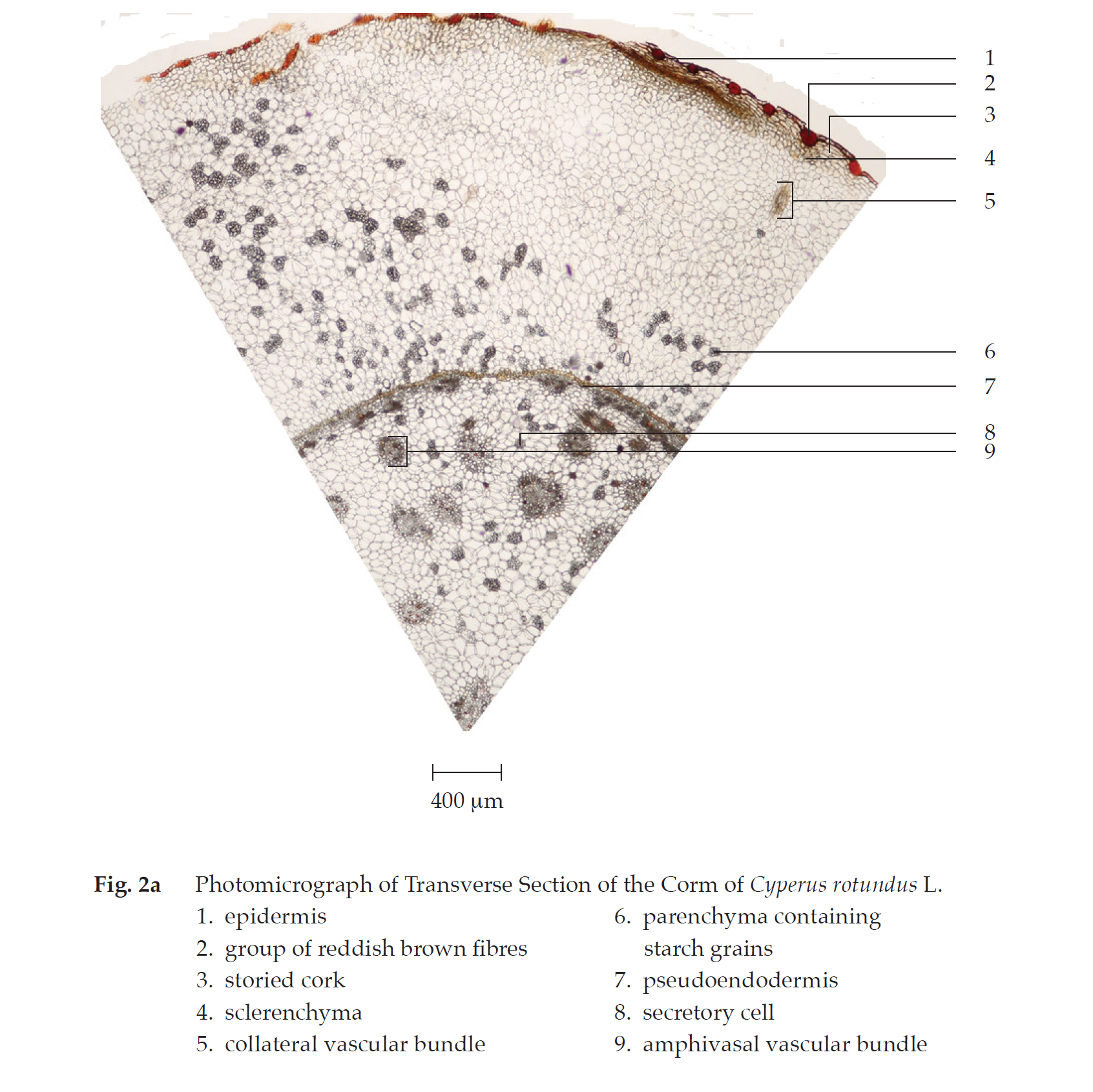

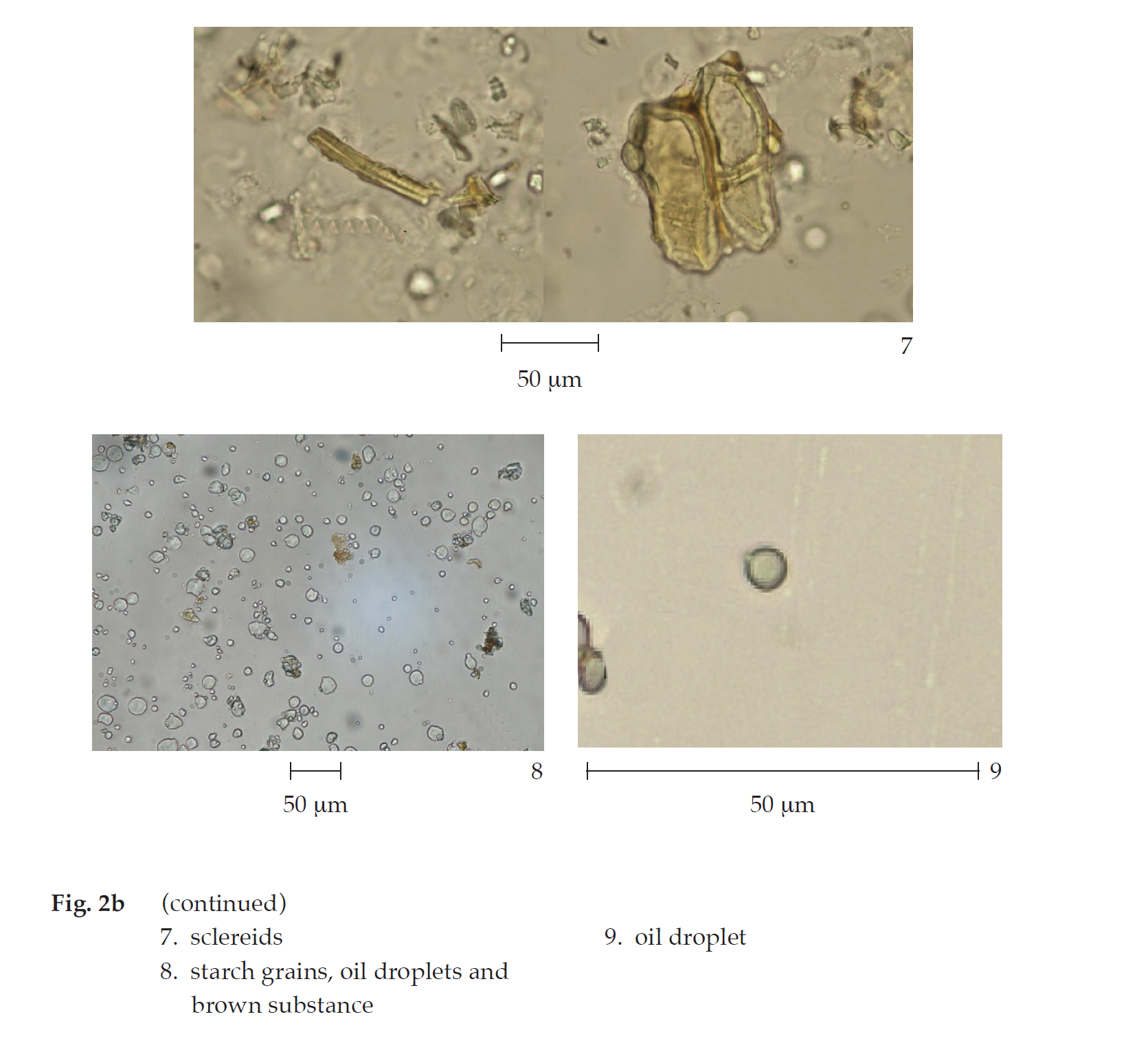
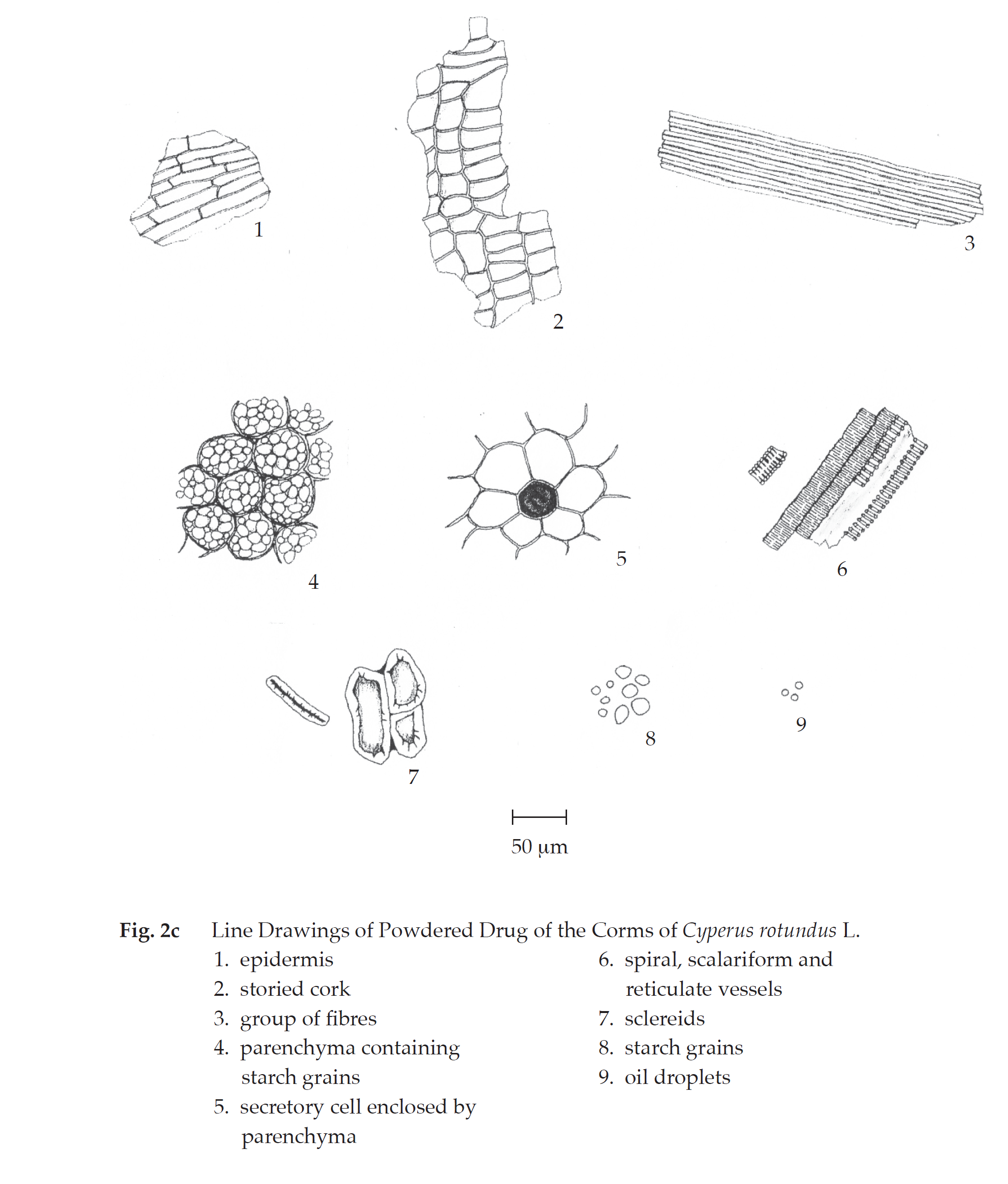
Additional information When the cyperus rotundus corms are pre-processed by steaming, fractures of the unsteamed corms are white and starchy with prominent endodermis ring, dark stele and scattering dotted vascular bundles, while the steamed ones are yellowish brown to reddish brown in colour.
Packaging and storage Cyperus Rotundus Corm shall be kept in well-closed containers, protected from light, and stored in a cool and dry place.
Identification
A. Boil 1 g of the sample, in powder, with 10 mL of water for 15 minutes and filter. To 2 mL of the filtrate, add a few drops of ninhydrin TS and warm on a water-bath: a violet colour is produced.
B. Sonicate 1 g of the sample, in powder, with 10 mL of methanol for 30 minutes and filter. To 2 mL of the filtrate, add 2 or 3 pieces of magnesium ribbon, shake well and mix with a few drops of hydrochloric acid: a reddish pink colour develops.
C. Carry out the test as described in the “Thin-Layer Chromatography” (Appendix 3.1), using silica gel 60 F254 as the coating substance and a mixture of 80 volumes of n-hexane and 20 volumes of acetone as the mobile phase. Apply separately to the plate as bands of 8 mm, 10 μL each of the following solutions. Prepare solution (A) by sonicating 2 g of the sample, in powder, with 10 mL of methanol for 10 minutes and filtering. Evaporate the filtrate to dryness under reduced pressure at 50°. Dissolve the residue in 1 mL of methanol. For solution (B), dissolve 2 mg of cyperotundone in 1 mL of methanol. After removal of the plate, allow it to dry in air and examine the plate under ultraviolet light (254 nm), marking the quenching bands. The chromatogram obtained from solution (A) shows a quenching band (hRf value 51 to 57) corresponding to the cyperotundone band obtained from solution (B) (Fig. 3).
Water Not more than 8.0 per cent v/w (Azeotropic Distillation Method, Appendix 4.12).
Foreign matter Not more than 2.0 per cent w/w (Appendix 7.2).
Acid-insoluble ash Not more than 2.0 per cent w/w (Appendix 7.6).
Total ash Not more than 5.0 per cent w/w (Appendix 7.7).
Ethanol-soluble extractive Not less than 4.0 per cent w/w (Appendix 7.12).
Water-soluble extractive Not less than 11.0 per cent w/w (Appendix 7.12).
Volatile oil Not less than 1.0 per cent v/w, calculated on the anhydrous basis (Appendix 7.3H). Use 15 g, in moderately coarse powder, freshly prepared and accurately weighed. Use 200 mL of water as the distillation liquid and a 500-mL round-bottomed flask. Distil at a rate of 2 to 3 mL per minute for 3 hours. Use 2.0 mL of xylene in the graduated tube.
